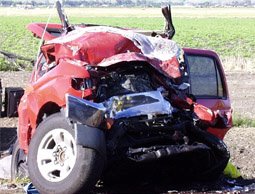 Modern agriculture practices here in the United States of America require incredible fossil fuel inputs to produce the food that feeds us. An often overlooked input is the commercial fertilizers used to provide the nutrients necessary to grow food in this manner.
Modern agriculture practices here in the United States of America require incredible fossil fuel inputs to produce the food that feeds us. An often overlooked input is the commercial fertilizers used to provide the nutrients necessary to grow food in this manner.“Natural gas is a primary ingredient in the production of commercial fertilizer.”
“Nitrogen fertilizer prices have been high for several months now. In some cases, the price has gone up 50 percent or more, but why is it increasing? The price of nitrogen fertilizers is directly related to the price of natural gas.”
"Gas production has peaked in North America," [Exxon]Chief Executive Lee Raymond told reporters at the Reuters Energy Summit.
There are many reasons to learn how to grow your own food. The coming peak in global oil production will cause many problems for the gigantic agrobiz corporations that currently farm a huge percentage of the food we eat and then ship it on average 1,500 miles from the fields where it’s grown to our grocery stores. If you’re interested in the alternative of growing your own food right in your own backyard you will have to be able to provide the necessary nutrients your plants need year after year. As natural gas production continues to decline it will be difficult and expensive to do so if you’re reliant on commercial fertilizer products. So how can you produce the nutrients necessary to grow your crops? One way is to compost.
Do you recycle? For most Americans this means simply separating certain items from the trash they throw away and placing them in another container for garbage collection day. Composting can be just as easy. I am going to discuss several options for using nutrients that already exist in your daily lives as food for your garden.
The key is to break the mindset of linear thinking. Many Americans think in terms of buying what they need, using it and throwing it in the trash. Then the trash collector comes, picks up the waste and takes it to the landfill to be buried in the ground. From the store to the landfill- end of story. The truth is that’s only one option. Recycling is another. Recycling begins to address cyclic patterns that are different from our current linear patterns. You buy and use a product and then return it to be reprocessed and made into a new product. Composting is the recycling of nutrients. It works the same way only it happens at your home. You buy the item and use it, then compost it on your property. Later you add the compost to your garden to help grow food for yourself. If you can separate your cans and bottles into a recycling container you can compost.
The key to successful composting is to make it clean and easy for you and your family. It is necessary to have a separate holding can for the organic materials you use and want to compost. This will reduce the number of trips you make outside to dump your compost material. What sort of material can you compost? Most kitchen scraps can be included. Any vegetable pieces or skins, leftover pasta, stale bread, coffee grinds, tea leaves, banana peels- almost anything that’s made primarily from plant products can be safely and easily composted. In addition egg shells and shrimp shells can be included. It’s not an especially good idea to compost meats or animal waste as these items can attract unwanted critters to your compost pile. There are ways to safely compost these materials but it’s easiest to start simple. So naturally your next question is about keeping kitchen scraps in a can in your home and how to keep it from smelling horrible. The compost storage system in my home does not smell. Here’s my solution.
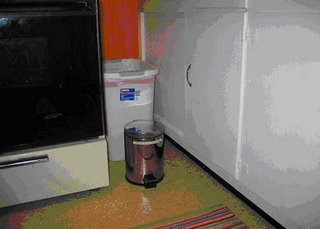 This small, stainless steel can sits in front of my general trash can. It includes a removal bucket I carry out to the compost pile. It has a lid that stays closed until I step on the pedal allowing me to dump in my scraps without touching anything. It’s small enough to hold several days’ worth of kitchen scraps and contain any odor. Even stylish versions are fairly inexpensive. After I dump the contents I use a hose to rinse out any scraps that stick to the bucket and I scrub it out with an old dish brush every few months. Even with this minimal amount of care it doesn’t cause an aroma problem. A simple solution for slight smells is to add a bit of citrus- a squeeze of lemon juice or a few orange peels just after empting the bucket. The acid keeps the anaerobic bacteria from getting established and causing a stink. We want the bacteria to break down our kitchens scraps but they can wait until we get them outside.
This small, stainless steel can sits in front of my general trash can. It includes a removal bucket I carry out to the compost pile. It has a lid that stays closed until I step on the pedal allowing me to dump in my scraps without touching anything. It’s small enough to hold several days’ worth of kitchen scraps and contain any odor. Even stylish versions are fairly inexpensive. After I dump the contents I use a hose to rinse out any scraps that stick to the bucket and I scrub it out with an old dish brush every few months. Even with this minimal amount of care it doesn’t cause an aroma problem. A simple solution for slight smells is to add a bit of citrus- a squeeze of lemon juice or a few orange peels just after empting the bucket. The acid keeps the anaerobic bacteria from getting established and causing a stink. We want the bacteria to break down our kitchens scraps but they can wait until we get them outside.Ok so we’ve solved the problem of temporary indoor storage without obnoxious odors by using our close-top can. What do you do with the material when the bucket fills up? There are two options, simple decomposition and animal processing.
Simple decomposition allows microbial organisms to naturally break down your kitchen scraps into compost. At its simplest you can pile up your material and let the process begin. Chose a sunny location that’s out of the way so it doesn’t interfere with other outdoor activities. Regardless of the size of your pile you may want to contain it so the waste items don’t get scattered all about. A simple setup involves acquiring pallets from your local grocery store. Many food items arrive on pallets and you can usually acquire them for free. Other sources such as hardware stores or shipping companies might also help you find cheap pallets. In truth any scrap wood can be used to create a container for your compost. Your goal is to build a cube roughly 3 feet wide by 3 feet long by 3 feet deep. It should be open on top and it helps to be able to remove one of the sides so as to have access to your compost when it’s finished. A bottom is not necessary. Here’s what your compost container might look like.

Wire mesh looped in a circle also provides an adequate compost container. Make sure the size of the wire openings is appropriate for the small size of your kitchen scrap material.
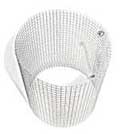
Some people like to use plastic garbage cans with holes drilled into the sides.
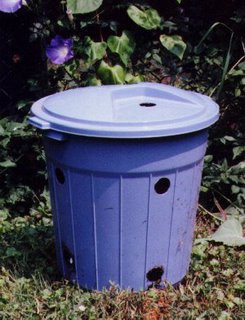
And as usual there are manufactured options.
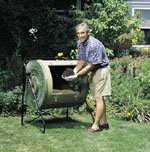 link
linkRemember not to create solid sides because air needs to be able to come in contact with as much of the pile as possible. This will discourage smelly anaerobicbacteria and speed up the process. Anaerobic bacteria thrive only in the absence of oxygen. They tend to produce odors unpleasant to humans, specifically the neighbors you don’t want to annoy. Alternatively aerobic bacteria need oxygen to thrive. These bacteria will also break down your kitchen scraps but won’t stink up the place. This means if you want a clean-smelling compost operation you have to let in air. You can also turn your pile or mix it up every so often to encourage air flow. This will also speed up the process.
These microorganisms also need water. Normal rainfall in most areas should take care of this need but you will want to water the pile if it gets dry, especially if you live in an area that receives little rain. You can buy compost starter that will give your pile a beginning boost but it isn’t necessary. The microorganisms you’re looking for will show up without any help. Again it just speeds things up.
In addition to using kitchen scraps you can compost fallen leaves and grass clippings. These items are often available in large quantities at certain times of the year. They can help you build up a hefty amount of compost in a hurry. The leaves are mostly carbon and the grass clippings and kitchen scraps are mostly nitrogen. Both are necessary to promote a healthy compost pile. You’re looking for a ratio of about 25 to 1 or 25 times as much carbon as nitrogen. It’s easier to think in terms of brown and green. Most compostable material that is brown in color is made up of carbon. Most of the compostable material that is green in color is made up of nitrogen (this also includes kitchen scraps). Think more brown and less green. Weeds with seeds and large branches are to be avoided however. If your pile isn’t balanced with the above ratio don’t worry, it will still break down it might just take longer. This does mean though that you can turn a whole lot of leaves into wonderful food for your garden with just a little bit of kitchen waste. I’ll avoid giving more specific directions because trial and error are unavoidable and irreplaceable as teaching tools. I’ll get you started. Write me if the stuff doesn’t rot.
There is another option for recycling your food scraps into compost. You can let animals do the work for you. The advantages are faster composting and reduced piles of kitchen scraps lying around. The disadvantage can be that you will have to take care of these additional members of your homestead. There are several species ready to assist you.

Worms. You can use worms to eat your leftover food and quickly turn it into worm castings, a wonderful compost for your garden. The term is called vermiculture.
link
A system like this can be used indoors or out with almost no odor. You place food scraps in the top and the worms eat them turning the waste into castings that fall through into the lower chamber for your use in the garden. Any extra worms can be added to your garden or used by fishermen. Red worms, European night crawlers or even meal worms can be used to quickly process your compost. My meal worms live outdoors.
By the way, the chickens love meal worms as a treat. Speaking of which…
Chickens. They can also be used to process kitchen scraps. I previously discussed chickens as a way to create compost here. In short you feed the chickens your leftover food and rake up their manure. You must allow the chicken manure to sit or cure for a while or it will burn your plants. The only animal whose manure you can use immediately is…
The Rabbit. Rabbits eat greens and other kitchen scraps and produce round droppings that can but put directly into the garden to nourish your plants. Too many meals of straight greens may cause problems with the digestive tracts of rabbits. It’s not wise to feed them strictly food scraps without also providing them rabbit pellet food. I’ll save more on raising and caring for rabbits for another post.
Integrated systems exist for using multiple animals to more completely and quickly process waste food. Often rabbits are fed scraps and then rabbit manure is fed to chickens or to worms for further processing. This sort of discussion however is beyond the scope of this introductory article. For more check this out.
Whether you’re interested in using worms to compost your waste out of curiosity, looking to close some of the loops of wasteful linear patterns so prevalent in our society or just searching for a way to provide the nutrients your new garden requires, composting is easy. You should give it a try. It's just this easy.




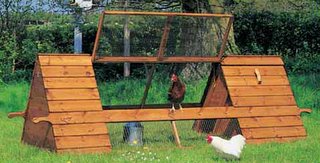


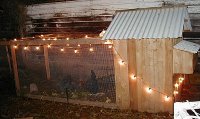





 Victory Gardens:
Victory Gardens: Seed Sources:
Seed Sources:


